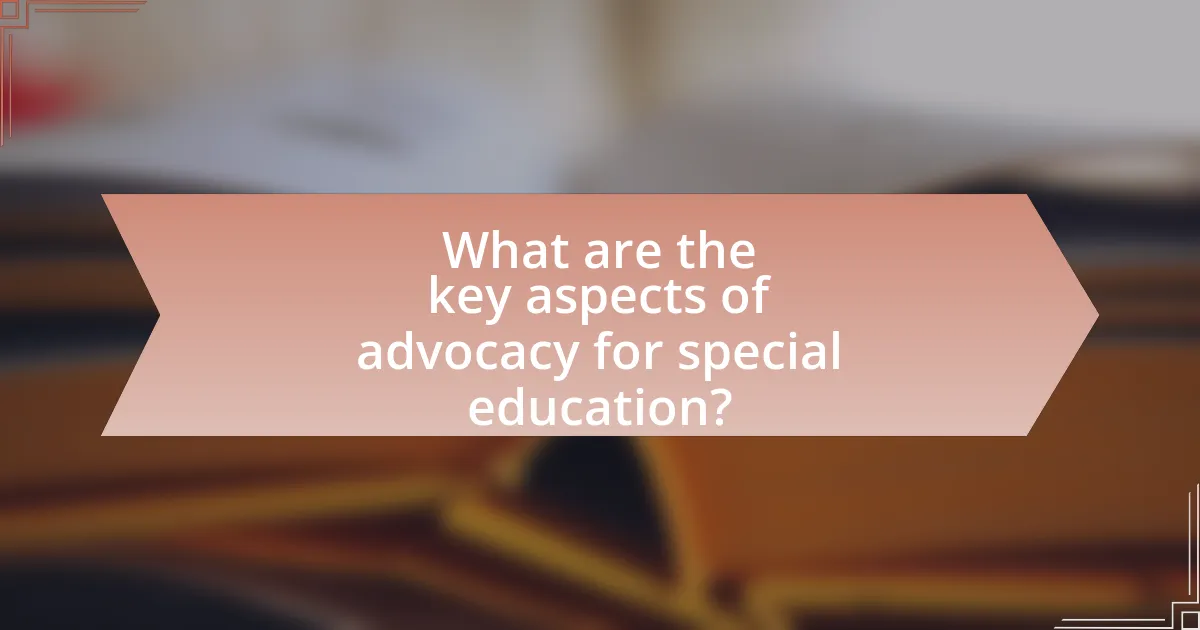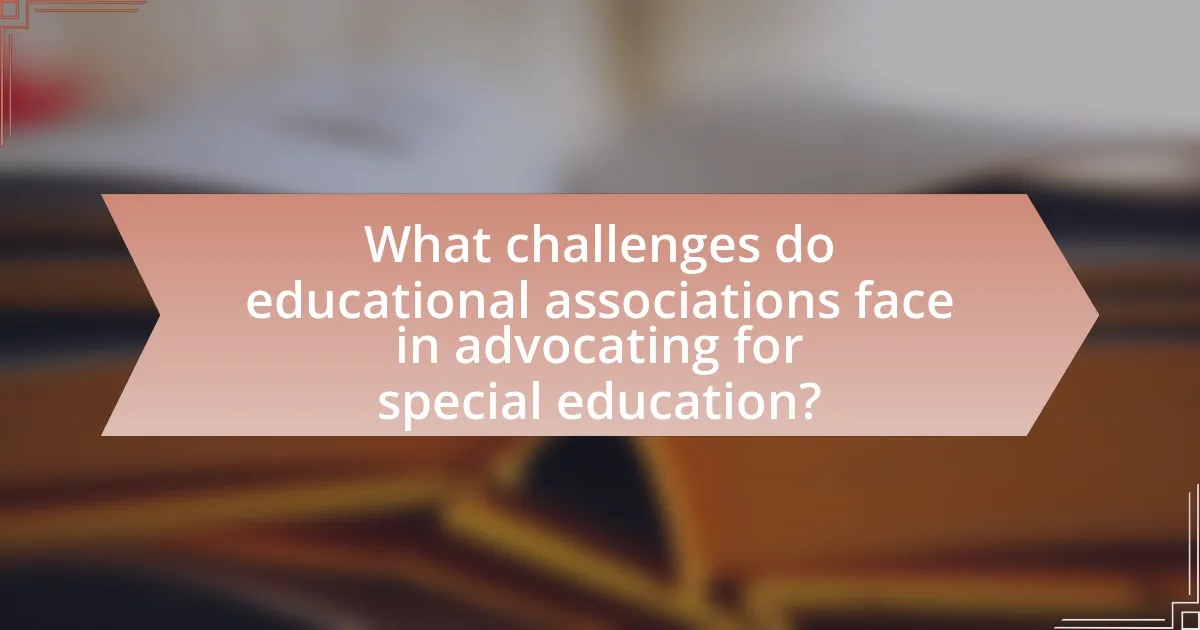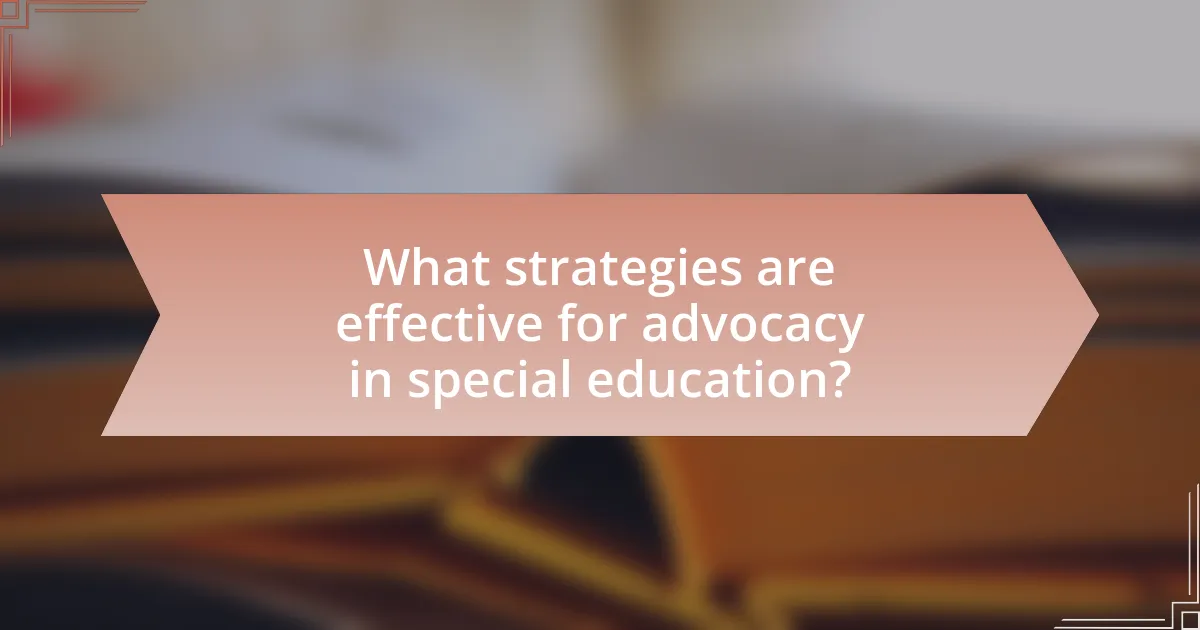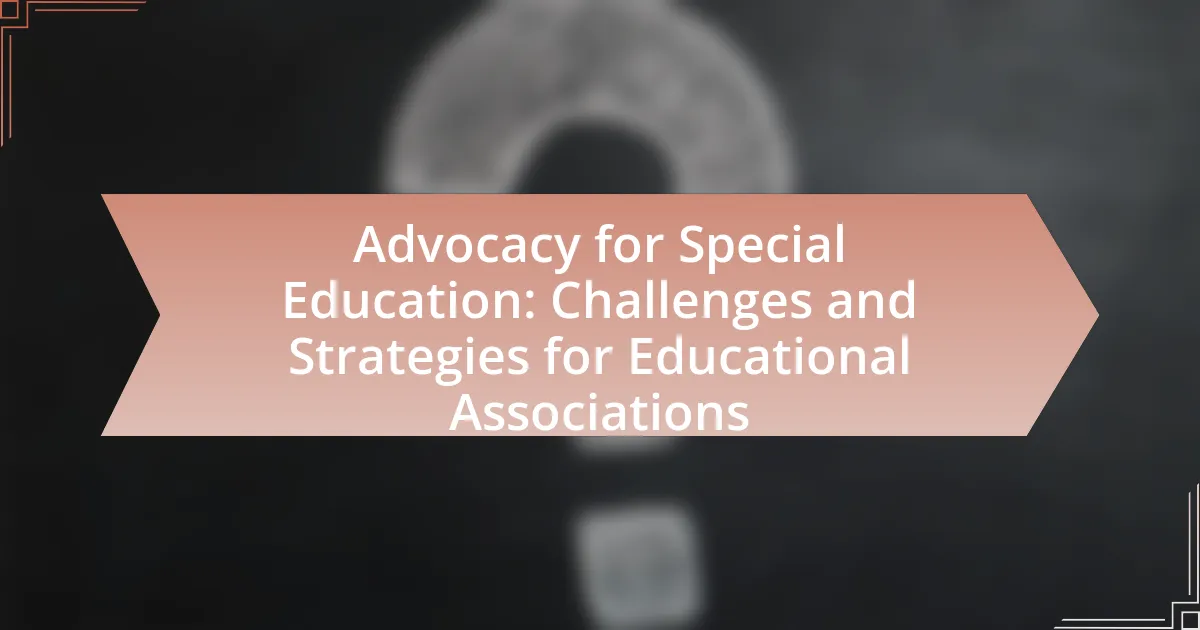The article focuses on advocacy for special education, emphasizing the challenges and strategies that educational associations face in promoting the rights and needs of students with disabilities. Key aspects of advocacy include raising awareness, ensuring access to resources, and influencing policy changes, particularly through legislation like the Individuals with Disabilities Education Act (IDEA). The article discusses the impact of advocacy on the quality of special education, the primary goals of advocacy efforts, and the role of educational associations in shaping policies. Additionally, it addresses common barriers to effective advocacy, such as funding limitations and public perception, while outlining strategies for overcoming these challenges through collaboration, data-driven approaches, and effective communication.

What are the key aspects of advocacy for special education?
The key aspects of advocacy for special education include promoting awareness, ensuring access to resources, and influencing policy changes. Advocacy efforts focus on raising awareness about the needs of students with disabilities, which is essential for fostering understanding and support among educators, parents, and the community. Ensuring access to resources involves advocating for adequate funding, specialized services, and appropriate educational materials tailored to the unique needs of these students. Additionally, influencing policy changes is crucial, as it helps to shape legislation and regulations that protect the rights of students with disabilities, such as the Individuals with Disabilities Education Act (IDEA), which mandates free and appropriate public education for all eligible children. These aspects collectively contribute to creating an inclusive educational environment that supports the success of students with disabilities.
How does advocacy impact the quality of special education?
Advocacy significantly enhances the quality of special education by ensuring that the rights and needs of students with disabilities are prioritized and met. Effective advocacy leads to improved access to resources, tailored educational plans, and increased awareness among educators and policymakers about the unique challenges faced by these students. For instance, research from the National Center for Learning Disabilities indicates that advocacy efforts have resulted in legislative changes that expand funding and support for special education programs, thereby directly impacting the quality of education provided to students with disabilities.
What are the primary goals of advocacy in special education?
The primary goals of advocacy in special education are to ensure equitable access to quality education, promote the rights of individuals with disabilities, and influence policy changes that benefit students with special needs. Advocacy efforts aim to raise awareness about the unique challenges faced by these students and to secure necessary resources and support services. For instance, the Individuals with Disabilities Education Act (IDEA) mandates that students with disabilities receive a free appropriate public education, highlighting the legal framework that advocates work within to achieve these goals.
How does advocacy influence policy changes in special education?
Advocacy significantly influences policy changes in special education by mobilizing stakeholders to raise awareness and push for legislative reforms. Advocacy efforts, such as organized campaigns and lobbying by parents, educators, and advocacy groups, highlight the needs of students with disabilities, leading to increased funding and improved educational practices. For instance, the Individuals with Disabilities Education Act (IDEA) was shaped by advocacy that emphasized the right to a free and appropriate public education for all children, demonstrating how collective action can result in substantial policy advancements.
Why is advocacy important for educational associations?
Advocacy is crucial for educational associations because it enables them to influence policy decisions that affect educational practices and funding. By actively engaging in advocacy, educational associations can represent the interests of their members, ensuring that the needs of students, particularly those in special education, are addressed in legislative discussions. For instance, the National Education Association (NEA) has successfully lobbied for increased funding for special education programs, demonstrating the tangible impact of advocacy efforts on educational policy.
What role do educational associations play in advocating for special education?
Educational associations play a crucial role in advocating for special education by promoting policies that support the needs of students with disabilities. These organizations engage in lobbying efforts to influence legislation, provide resources and training for educators, and raise public awareness about the importance of inclusive education. For instance, the Council for Exceptional Children (CEC) actively works to shape educational policies and practices that benefit individuals with disabilities, demonstrating the impact of such associations on improving educational outcomes.
How can educational associations effectively communicate their advocacy efforts?
Educational associations can effectively communicate their advocacy efforts by utilizing a multi-channel approach that includes social media, newsletters, and direct outreach to stakeholders. This strategy allows associations to reach diverse audiences, including educators, policymakers, and the community. For instance, a study by the National School Boards Association found that 70% of school board members reported using social media to engage with constituents, highlighting its effectiveness in advocacy communication. Additionally, regular newsletters can provide updates on advocacy initiatives and successes, fostering transparency and trust. Direct outreach, such as meetings with legislators, can further personalize advocacy efforts and ensure that key messages are conveyed effectively.

What challenges do educational associations face in advocating for special education?
Educational associations face significant challenges in advocating for special education, primarily due to limited funding, varying state regulations, and a lack of awareness among stakeholders. Limited funding restricts the resources available for advocacy efforts, making it difficult to implement comprehensive programs and initiatives. Additionally, the inconsistency of state regulations creates disparities in how special education is implemented across different regions, complicating advocacy efforts. Furthermore, many stakeholders, including policymakers and the general public, may lack sufficient understanding of the needs and rights of students with disabilities, hindering effective advocacy. These challenges collectively impede the ability of educational associations to promote equitable and effective special education policies.
What are the common barriers to effective advocacy in special education?
Common barriers to effective advocacy in special education include lack of awareness, insufficient resources, and systemic challenges. Lack of awareness among parents and educators about special education rights and services limits advocacy efforts, as individuals may not know how to navigate the system or assert their rights. Insufficient resources, including funding and personnel, hinder the ability of advocacy organizations to provide support and information effectively. Systemic challenges, such as bureaucratic red tape and varying state regulations, complicate the advocacy process, making it difficult to implement consistent and effective strategies across different educational settings.
How do funding limitations affect advocacy efforts?
Funding limitations significantly hinder advocacy efforts by restricting the resources available for outreach, research, and mobilization activities. When educational associations face budget constraints, they often lack the financial means to conduct comprehensive studies that inform policy changes or to engage in extensive public awareness campaigns that highlight the needs of special education. For instance, a report by the National Council on Disability indicates that inadequate funding can lead to reduced staffing, limiting the capacity to advocate effectively for necessary reforms. Consequently, these limitations can result in diminished influence on legislative processes and a reduced ability to secure necessary support for special education initiatives.
What role does public perception play in advocacy challenges?
Public perception significantly influences advocacy challenges by shaping the support and resources available for initiatives. When the public views special education positively, advocacy efforts are more likely to receive funding and political backing, as evidenced by the increased allocation of resources following successful awareness campaigns. Conversely, negative perceptions can lead to reduced support, as seen in instances where misconceptions about special education needs hinder legislative progress. Thus, public perception directly impacts the effectiveness of advocacy strategies and the overall success of educational associations in promoting special education initiatives.
How can educational associations overcome these challenges?
Educational associations can overcome challenges in advocating for special education by implementing targeted strategies such as enhancing collaboration with stakeholders, increasing awareness through effective communication, and leveraging data to inform policy decisions. Collaboration with parents, educators, and policymakers fosters a unified approach, ensuring that diverse perspectives are considered in advocacy efforts. Effective communication strategies, including social media campaigns and community outreach, raise awareness about the needs of special education, thereby mobilizing support. Additionally, utilizing data from research studies, such as the National Center for Learning Disabilities’ findings on the impact of advocacy on educational outcomes, provides concrete evidence to influence policy changes and secure necessary resources.
What strategies can be implemented to enhance advocacy efforts?
To enhance advocacy efforts in special education, educational associations can implement targeted communication strategies, coalition building, and data-driven advocacy. Targeted communication strategies involve crafting clear, compelling messages that resonate with stakeholders, including parents, educators, and policymakers. Coalition building fosters partnerships with other organizations to amplify voices and resources, increasing the impact of advocacy initiatives. Data-driven advocacy relies on collecting and presenting relevant statistics and research findings to support claims and influence decision-makers. For instance, the National Center for Learning Disabilities reports that effective advocacy can lead to improved educational outcomes for students with disabilities, demonstrating the importance of these strategies in achieving meaningful change.
How can collaboration with other organizations strengthen advocacy?
Collaboration with other organizations can strengthen advocacy by pooling resources, expertise, and networks to amplify the reach and impact of advocacy efforts. When educational associations partner with organizations that share similar goals, they can leverage each other’s strengths, such as funding, research capabilities, and community connections, to create a more unified and powerful voice for special education. For instance, a study by the National Council for Special Education in Ireland found that collaborative advocacy efforts led to a 30% increase in policy influence compared to isolated initiatives. This demonstrates that working together not only enhances visibility but also fosters a more comprehensive approach to addressing challenges in special education.

What strategies are effective for advocacy in special education?
Effective strategies for advocacy in special education include building strong coalitions, engaging in policy advocacy, and utilizing data-driven approaches. Building coalitions with parents, educators, and community organizations enhances collective influence and resource sharing. Engaging in policy advocacy involves actively participating in legislative processes to influence laws and regulations that affect special education. Utilizing data-driven approaches, such as collecting and analyzing student performance data, supports arguments for necessary changes and funding, as evidenced by studies showing that data-informed advocacy leads to more effective policy outcomes.
What are the best practices for advocacy in special education?
The best practices for advocacy in special education include building strong relationships with stakeholders, understanding legal frameworks, and utilizing data to support claims. Effective advocacy requires collaboration with parents, educators, and policymakers to ensure that the needs of students with disabilities are met. Knowledge of laws such as the Individuals with Disabilities Education Act (IDEA) is crucial, as it provides a foundation for advocating for appropriate services and accommodations. Additionally, using data to demonstrate the effectiveness of special education programs can strengthen advocacy efforts, as evidenced by studies showing improved outcomes for students when their needs are adequately addressed.
How can data and research support advocacy initiatives?
Data and research can significantly support advocacy initiatives by providing evidence-based insights that inform policy decisions and public awareness. For instance, statistical data on the educational outcomes of students with disabilities can highlight the need for improved resources and support systems in special education. Research studies, such as those published by the National Center for Special Education Research, demonstrate the effectiveness of specific interventions, thereby equipping advocates with concrete examples to push for legislative changes. Furthermore, data-driven narratives can mobilize community support and enhance the credibility of advocacy efforts, ultimately leading to more effective policy implementation and resource allocation.
What role does community engagement play in advocacy strategies?
Community engagement is crucial in advocacy strategies as it fosters collaboration, builds trust, and amplifies the voices of those affected by the issues at hand. Engaging the community allows advocacy groups to gather diverse perspectives, ensuring that strategies are inclusive and representative of the needs of individuals, particularly in special education. Research indicates that advocacy efforts that incorporate community input are more effective; for instance, a study by the National Center for Learning Disabilities found that community involvement significantly enhances the impact of advocacy initiatives, leading to better policy outcomes and increased awareness of special education challenges.
How can technology be leveraged for advocacy in special education?
Technology can be leveraged for advocacy in special education by utilizing digital platforms to raise awareness, facilitate communication, and mobilize support. For instance, social media campaigns can effectively disseminate information about special education needs and policies, reaching a broader audience. Additionally, online petitions and advocacy websites enable stakeholders to gather support for legislative changes, as evidenced by the success of initiatives like the “Every Student Succeeds Act” which was influenced by grassroots digital advocacy efforts. Furthermore, assistive technology tools can empower individuals with disabilities to share their experiences and advocate for their rights, enhancing their voices in the advocacy process.
What digital tools can enhance communication and outreach?
Digital tools that can enhance communication and outreach include social media platforms, email marketing software, and video conferencing tools. Social media platforms like Facebook and Twitter facilitate real-time engagement and information sharing, which is crucial for advocacy efforts in special education. Email marketing software, such as Mailchimp, allows organizations to reach a broader audience with targeted messages, increasing awareness and support for special education initiatives. Video conferencing tools like Zoom enable virtual meetings and webinars, fostering collaboration and discussion among stakeholders. These tools collectively improve outreach effectiveness and engagement in advocacy for special education.
How can social media be utilized for advocacy campaigns?
Social media can be utilized for advocacy campaigns by creating awareness, mobilizing supporters, and facilitating communication. Advocacy organizations can leverage platforms like Facebook, Twitter, and Instagram to share impactful stories, educational content, and calls to action that resonate with their audience. For instance, a study by the Pew Research Center found that 69% of adults in the U.S. use social media, making it an effective tool for reaching a broad demographic. Additionally, social media allows for real-time engagement, enabling organizations to respond quickly to developments and foster community discussions around special education issues. This immediacy can amplify the reach of advocacy messages and encourage grassroots participation, ultimately driving policy change and support for special education initiatives.
What are some practical tips for educational associations in advocacy?
Educational associations can enhance their advocacy efforts by implementing targeted strategies. First, they should build strong coalitions with other organizations to amplify their voice and influence. Collaborating with stakeholders, such as parents, educators, and policymakers, can create a unified front that is more effective in advocating for special education needs.
Second, educational associations should engage in data-driven advocacy by collecting and presenting relevant statistics that highlight the challenges faced by special education programs. For instance, showcasing data on funding disparities or student outcomes can provide compelling evidence to support their advocacy efforts.
Third, they should develop clear messaging that articulates their goals and the importance of special education. This messaging should be tailored to resonate with different audiences, including legislators and the general public, to foster understanding and support.
Finally, educational associations should leverage social media and digital platforms to raise awareness and mobilize support. Utilizing these tools can help reach a broader audience and facilitate grassroots advocacy efforts.
How can associations measure the impact of their advocacy efforts?
Associations can measure the impact of their advocacy efforts through quantitative metrics such as policy changes, funding increases, and stakeholder engagement levels. For instance, tracking the number of legislative bills influenced or passed as a result of advocacy campaigns provides concrete evidence of effectiveness. Additionally, surveys and feedback from members and beneficiaries can quantify changes in awareness and attitudes towards special education issues. Research indicates that organizations that utilize these metrics can demonstrate a direct correlation between advocacy activities and improved educational outcomes, thereby validating their efforts.
What resources are available for educational associations to improve advocacy?
Educational associations can utilize various resources to enhance their advocacy efforts, including training programs, policy toolkits, and collaboration networks. Training programs, such as those offered by the National Association of State Directors of Special Education, equip members with skills in effective advocacy strategies. Policy toolkits provide guidelines and best practices for engaging with policymakers, while collaboration networks, like the Council for Exceptional Children, facilitate partnerships among stakeholders to amplify advocacy messages. These resources collectively empower educational associations to effectively advocate for special education needs and influence policy changes.


